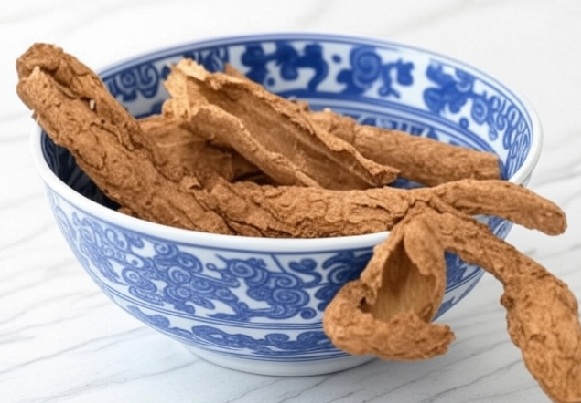Acanthopanax Root Chinese Herb

Acanthopanax Root (Wu Jia Pi): A Strengthening Herb for Joints, Qi, and Aging
Introduction
Acanthopanax root, known as Wu Jia Pi (五加皮) in Traditional Chinese Medicine (TCM), is a warming and invigorating herb best known for strengthening the sinews and bones, expelling wind-dampness, and tonifying the Liver and Kidneys. Traditionally used to relieve joint pain, fatigue, and weakness in the lower body, Wu Jia Pi is particularly useful for the elderly, growing children, or anyone recovering from injury or chronic musculoskeletal conditions. Its uplifting nature makes it a valuable tonic for physical strength and mobility.
What Is Acanthopanax Root?
Wu Jia Pi is the root bark of Acanthopanax gracilistylus or related species in the Eleutherococcus genus. In TCM, it is classified as acrid, bitter, and warm in nature. It enters the Liver and Kidney meridians and is used to expel wind-damp, strengthen the tendons and bones, and promote urination to reduce swelling. Wu Jia Pi is often found in formulas for joint stiffness, leg weakness, and fatigue due to Liver and Kidney deficiency.
Health Benefits of Acanthopanax Root
Strengthens Sinews and Bones
Wu Jia Pi is well-known for reinforcing joint strength and is commonly used in cases of chronic back pain, knee weakness, or muscle atrophy.
Expels Wind-Damp and Relieves Pain
It helps eliminate external wind-dampness, which can cause joint stiffness, arthritic pain, or heaviness in the limbs.
Tonifies Liver and Kidney Qi
By nourishing the source organs responsible for strength and stability, Wu Jia Pi enhances endurance, stamina, and resilience.
Promotes Urination and Reduces Swelling
It is mildly diuretic and is used for edema, especially in the lower limbs due to water retention from Spleen or Kidney deficiency.
Supports Growth and Development in Children
Often used for delayed walking, weak bones, or low immunity in children due to constitutional weakness.
How to Use Acanthopanax Root
In Herbal Decoctions or Tonic Broths
Simmer 6–15 grams of Wu Jia Pi with herbs like Du Zhong, Niu Xi, or Dang Gui for 30–60 minutes to strengthen bones and relieve pain.
In Warming Soups or Recovery Teas
Use in nourishing broths for post-injury or elderly tonics, especially alongside bone-supporting herbs and warming qi tonics.
In Traditional Wine Infusions
Wu Jia Pi is sometimes soaked in rice wine with other herbs for external use or taken in small amounts to ease rheumatism and support mobility.
Where to Buy Acanthopanax Root
You can find Wu Jia Pi at the following places:
-
Chinese herbal medicine shops
-
TCM apothecaries and online herbal retailers
-
Specialty supplement brands with tonic formulas
Look for:
-
Dried root bark slices or shavings with a woody, aromatic scent
-
Organic or wildcrafted sources
-
GMP or lab-tested packaging for safety and authenticity
Are There Any Side Effects?
Wu Jia Pi is generally safe when used in traditional doses. Because it is warming, it may not be suitable for individuals with yin deficiency and internal heat. Avoid during acute infections, fevers, or inflammation unless directed by a practitioner. Use cautiously in pregnancy and avoid high doses in young children without supervision.
Conclusion
Acanthopanax root, or Wu Jia Pi, is a warming and revitalizing herb used in TCM to strengthen joints, expel dampness, and enhance mobility. Whether brewed in bone-strengthening teas or added to traditional soups, this herb is a trusted ally for those facing fatigue, joint weakness, or age-related decline.
FAQs
Can I take Acanthopanax root every day?
Yes, it can be taken daily in moderate doses, especially in formulas for joint support, weakness, or post-illness recovery.
What does Acanthopanax root taste like?
It has a slightly bitter, earthy flavor with a warm, woody aroma when decocted.
Is Acanthopanax root safe for children?
Yes, in low doses and under herbal supervision, especially for weak legs or slow development in children.

